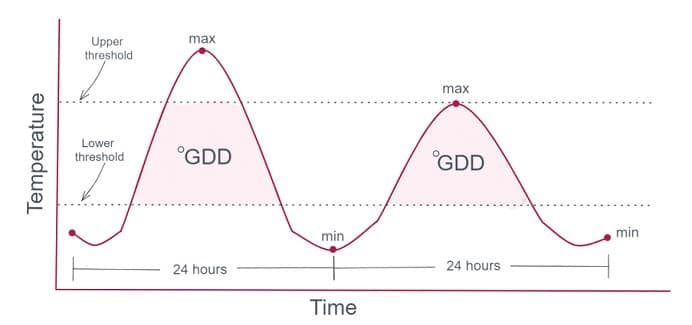In the development of the vine, as well as in the development of any living being, the conditions under which it will be grown are of essential importance. It is known that the parameters of temperature and humidity in which a given vineyard is grown are the most influential. They play an important role not only for the plant’s physiology, but also for the development of pathogens on the vines.
Тhe number of GDD that fall between a lower and upper temperature threshold, for each 24-hour period.
Oftentimes when we read viticulture literature we come across the term Growing Degree Days (GDD), which is used to measure the total amount of average daily temperatures above 10 °C during the growing season of the vines. The normal biochemical and physiological processes during the phenological growth of vine depends on the temperature. Therefore, the initial stages of plant development depend directly on the GDD values, the higher they are, the earlier the bud burst and blooming will start. Also, at a higher temperature value, the growth of the shoots is stronger, and the flowering period is shortened.
Image 1: Bud opening; Image 2: Blooming
The GDD parameter is undoubtedly of great help to agronomists to predict not only plant phenophases but also development of pathogens and insect attacks. Accurate information obtained from this indicator could save unnecessary treatments in the vineyard or optimize the pest control through minimal intervention, when treatment is done at the right time. The optimal vineyard management during the whole year is directly connected to the ability to determine the start of each phenophase.
Phenological calendar by Bevine
Each grape variety has different requirements for the number of growing degree days to reach maturity, but in general grapes need 115-120 days on average to accumulate their required amount of heat. Based on this indicator, on a global scale, a division can be made both by varieties (late, mid-ripening and early) and by regions (cool, hot, or with moderate climate):
GDD: 2100 – 2800 °C of early ripening varieties such as Pinot Noir, Chardonnay, Sauvignon Blanc, Riesling, Tamianka, Traminer, and some of the regions that fall into this group are Champagne and Burgundy;
GDD: 2800 – 3500 °C medium ripening varieties as Cabernet Sauvignon, Barbera, Merlot, Gamza, Miket Vratchanski, Pamid, some of the regions are Bordeaux, Rhone Valley, Napa, Sonoma;
GDD: over 3500 °C varieties are late ripening such as Shiroka Melnishka loza, Alicante bouschet, Mavrud, and California is a region belongs to this group;
Image 1: Ripening ; Image 2: Harvesting
It is known that the amount of accumulated sugars and acids in the grapes is directly related to the accumulated temperature during the year and especially during the ripening phase. The use of agricultural software collecting information during the year of GDD values, would predict with great accuracy a harvest date which is a prerequisite for better work planning in the wine industry.




